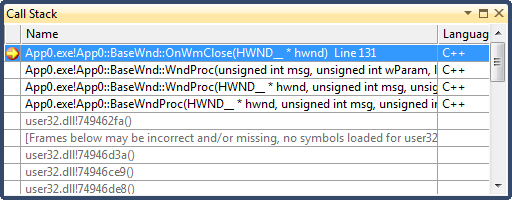App0 is a C++ wrapper over Windows API calls for a typical windowed application. This is similar to the framework used in curve. The design is mostly drawn from Win32 Programming by James M. Newcomer and Brent Rector.
The BaseWnd class wraps around a HWND. CreateWindowEx is called in the constructor. Before the CreateWindowEx call, I register the window class if it has not already been registered.
|
1 2 3 4 5 6 7 8 9 10 11 12 13 14 15 |
BaseWnd::BaseWnd(void): hwnd(0) { if(wndClassAtom == 0){ if(Register() == 0) throw app0_exception(ERR_CLASS_REGISTRATION_FAILED); } hwnd = CreateWindowEx(WS_EX_OVERLAPPEDWINDOW, MAKEINTATOM(wndClassAtom), WINDOW_TITLE, WS_OVERLAPPEDWINDOW, CW_USEDEFAULT, 0, CW_USEDEFAULT, 0, 0, 0, GetModuleHandle(0), this); if(hwnd == 0) throw app0_exception(ERR_WINDOW_CREATION_FAILED); } |
Since the WindowProc cannot be a member function, I use two non-members: InitWndProc is used till a WM_CREATE is received and BaseWndProc is used for the rest of the windows lifetime.
InitWndProc forwards all messages except WM_CREATE to DefWindowProc. WM_CREATE is forwarded to BaseWnd_OnCreate which saves the object pointer (passed to CreateWindowEx) at GWL_USERDATA and also replaces the window procedure (currently InitWndProc) with BaseWndProc.
|
1 2 3 4 5 6 7 8 9 |
LRESULT CALLBACK InitWndProc(HWND hwnd, UINT msg, WPARAM wParam, LPARAM lParam){ if(msg == WM_CREATE){ return HANDLE_WM_CREATE(hwnd, wParam, lParam, App0::BaseWnd_OnCreate); } else return ::DefWindowProc(hwnd, msg, wParam, lParam); } |
BaseWndProc forwards all messages to the static BaseWnd::WndProc method which retrieves the object pointer and forwards messages to the BaseWnd::WndProc instance method. The instance method behaves like a typical WindowProc and forwards selected messages to other instance methods (OnWmClose, OnWmDestroy) while relegating all other messages to DefWindowProc.
|
1 2 3 4 5 6 7 8 9 10 11 12 13 14 15 16 17 18 19 20 21 22 23 24 |
LRESULT CALLBACK BaseWndProc(HWND hwnd, UINT msg, // non-member WPARAM wParam, LPARAM lParam){ return BaseWnd::WndProc(hwnd, msg, wParam, lParam); } // static member LRESULT BaseWnd::WndProc(HWND hwnd, UINT msg, WPARAM wParam, LPARAM lParam){ LONG_PTR ptr = ::GetWindowLongPtr(hwnd, GWL_USERDATA); BaseWnd* window = reinterpret_cast if(window == 0) throw app0_exception(_T("Object pointer is 0.")); return window->WndProc(msg, wParam, lParam); } LRESULT BaseWnd::WndProc(UINT msg, WPARAM wParam, LPARAM lParam){ switch(msg){ HANDLE_MSG(hwnd, WM_CLOSE, OnWmClose); HANDLE_MSG(hwnd, WM_DESTROY, OnWmDestroy); } return ::DefWindowProc(hwnd, msg, wParam, lParam); } |

I use InitWndProc initially because until WM_CREATE the object pointer has not yet been attached to the HWND and BaseWndProc depends on the object pointer.
Download source here.